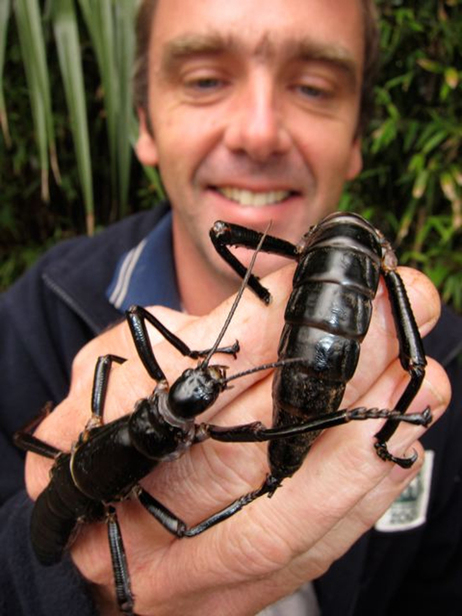A monstrous insect thought long-extinct has been clinging to survival on a tiny spike of volcanic rock that juts out of the Tasman Sea off the coast of Australia. Considered extinct since 1930 at its original home of Lord Howe Island, the six-inch-long, nocturnal bug nicknamed "tree lobster" has survived in a colony of only 30 or so insects on a nearby sliver of an island called Ball's Pyramid. Robert Krulwich chronicles the Lord Howe stick insect's rise from the dead at his NPR blog.
Like so many colonial mishaps, the rare stick insect was thought entirely wiped out when a British ship carrying black rats crashed near Lord Howe Island in 1918. The rats made it to shore and devoured the entire species in two years — or so we thought.
In fact, on a nearby tiny remnant of volcano — less than a mile long and 1,800 feet tall — the prehistoric-looking insect had a colony of its own. Nobody knows how they got there. A tempting challenge for climbers in the 1960s, people occasionally would report seeing black, hand-sized insects dead on the rocks at the base of Ball's Pyramid.
So two Australian scientists sought them out in 2001, and found them, scurrying around in the bushes in the dead of night.
They were alive and, to Nick Carlile's eye, enormous. Looking at them, he said, "It felt like stepping back into the Jurassic age, when insects ruled the world."
In the following years, scientists salvaged the species, but now the Australian government faces an unusual question: Where do they put them? Krulwich:
On Howe Island, their former habitat, the great-great-great-grandkids of those original black rats are still out and about, presumably hungry and still a problem. Step one, therefore, would be to mount an intensive (and expensive) rat annihilation program. Residents would, no doubt, be happy to go rat-free, but not every Howe Islander wants to make the neighborhood safe for gigantic, hard-shell crawling insects. So the Melbourne Museum is mulling over a public relations campaign to make these insects more ... well, adorable, or noble, or whatever it takes.
They are most certainly not adorable, but they are pretty interesting. Aside from size, they're pretty gnarly looking, with long, black legs and oily looking plates of armor, not unlike a roach. And they also pair off into couples, following the female's lead. They even cuddle at night.
They aren't the largest insects in the world (the horrifying hissing cockroach comes to mind), but the whole affair has a Lost World feel to it, with "Island Gigantism," rumored extinction, shipwrecks and explorers. A reminder that there are unseen places out there, and nobody knows what tiny King Kongs live under their bushes.
Six-Legged Giant Finds Secret Hideaway, Hides for 80 Years Robert Krulwich
photos by John White and Rod Morris (www.rodmorris.co.nz) via npr
